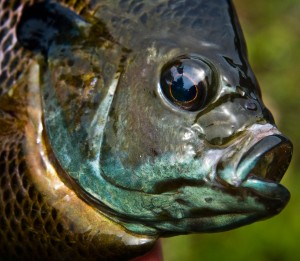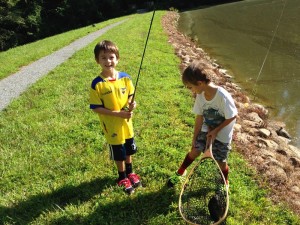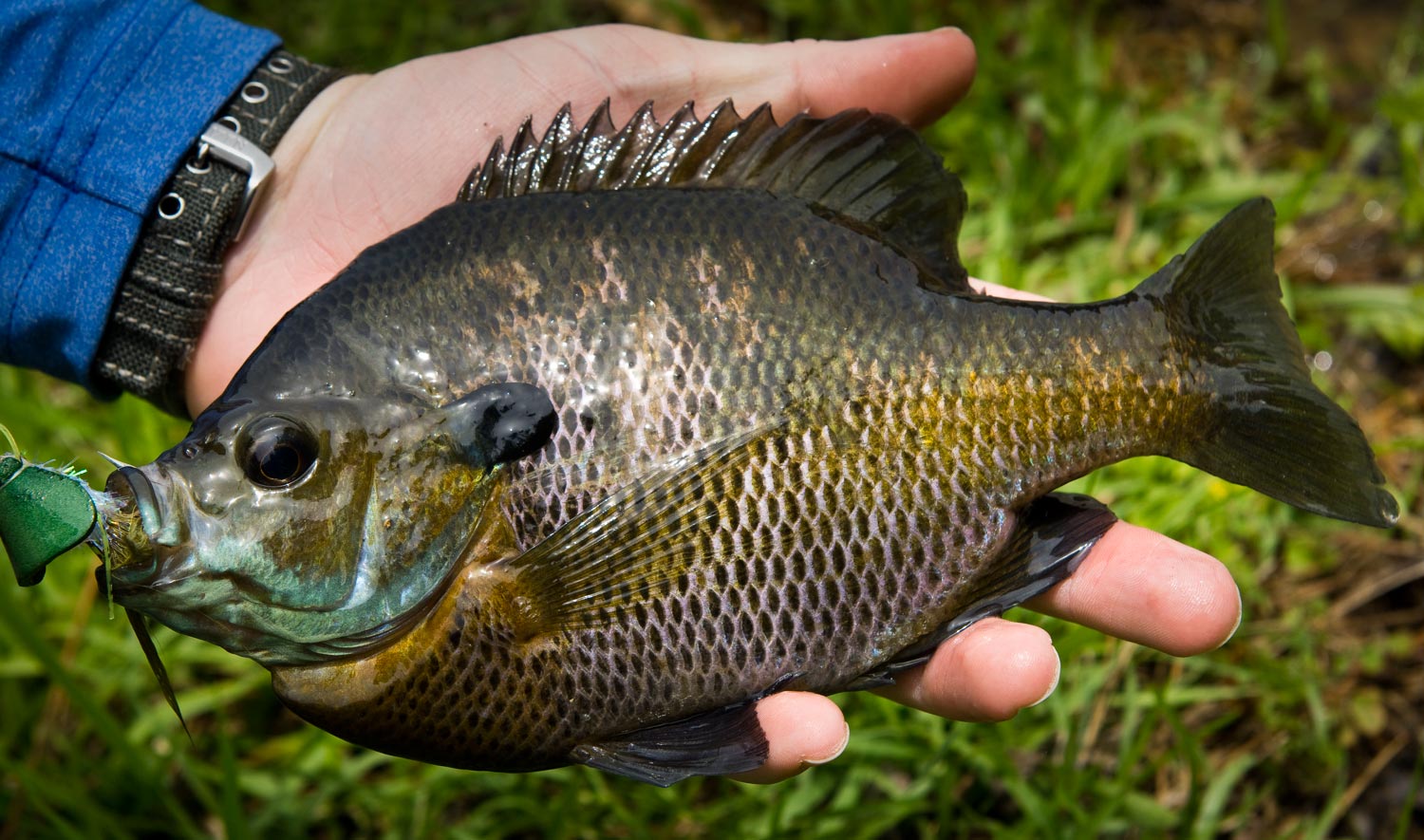By Justin Pickett
It’s bluegill time again.
Warmer temps, blooming flowers, and the buzzing sound of lawn mowers. Crazy, diehard bass anglers are trailering their $30,000 boats with their $50,000 trucks, and running 70mph across every lake in the country in order to chase after their favorite little green fish. Hell, the amount of money a bass angler may spend on gasoline this summer could probably fund a bachelor’s degree. As fishermen, we do some crazy things. Well worth it in my opinion, however, today I am standing on the bank of a local pond, three weight in hand, casting little poppers and #8 RLD’s.
This time of year is the height of the bluegill spawning season, and the best time to target the larger bluegill.
 That first full moon of May is typically when most bluegill anglers mark their calendars, though you can find them on the bed as early as March and April, and as late as June. These little guys are crazy aggressive and will sometimes make you think a 5lb bass has struck when they take your fly. They’re one of my favorite species of fish to catch on the fly. Their bright colors and never-give-up attitude makes them a treat for anglers looking for some fun. I swear if these things grew to ten or fifteen pounds, they’d be the largemouth bass of the world. If only they jumped.
That first full moon of May is typically when most bluegill anglers mark their calendars, though you can find them on the bed as early as March and April, and as late as June. These little guys are crazy aggressive and will sometimes make you think a 5lb bass has struck when they take your fly. They’re one of my favorite species of fish to catch on the fly. Their bright colors and never-give-up attitude makes them a treat for anglers looking for some fun. I swear if these things grew to ten or fifteen pounds, they’d be the largemouth bass of the world. If only they jumped.
Much of my childhood was spent on the banks of Lake Sinclair near Milledgeville, Ga. I would spend many of my summer weekends running around in my little jon boat, chucking little Bettes poppers along the banks and submerged timber. It was where I really learned how to cast a fly rod, and where I fell in love with fly fishing. On most days, there were always bluegill willing to strike at my fly, providing the positive feedback to keep me going no matter how frustrated I may have been with my casting abilities. These little guys are certainly one of the main reasons why I kept picking up my fly rod.
The learning curve in fly fishing is sharp for most. Put a beginner on a tight stream bank, with overhanging trees, and the need to cast into an area the size of a hula-hoop, and it can be extremely frustrating for them. Even when they get that cast right, they still have to get a trout to take the fly. Hell, there are still days where I feel like a beginner figuring things out. However, bluegill and other panfish species are plentiful and easy to access. Pretty much any pond or lake is likely to hold a good population of these little suckers. I used to catch some gnarly bluegill in a retention pond behind some apartments I lived in. I think they were juicing, and on a constant high provided by the second-hand smoke from the neighbors’ “medicine,” so they were always on the lookout for a snack. They also tend to be way less picky and will give a look at almost anything that hits the water. Ever spit over the side of a dock and see a handful of bluegill rise to the surface to check it out? They are everywhere and seemingly eager to jump on a hook.
There’s no need for fat wallets, fancy casts, or secret fly patterns, and the chances of hooking up are high.
 All you need is a three weight fly rod (or any rod for that matter), a 4x leader, a floating line, and some basic flies. I find that beetles, caddis, woolly buggers, rubber legged dragons, and small poppers are all you’ll need to have a great time on the water catching bluegill until the sunlight fades. Tenkara is also a great, fun-as-hell way to target bluegill and other panfish species. Look for them around docks, grass beds, and any other submerged structure. In my opinion, it’s the best way to get new anglers interested in fly fishing, especially kids.
All you need is a three weight fly rod (or any rod for that matter), a 4x leader, a floating line, and some basic flies. I find that beetles, caddis, woolly buggers, rubber legged dragons, and small poppers are all you’ll need to have a great time on the water catching bluegill until the sunlight fades. Tenkara is also a great, fun-as-hell way to target bluegill and other panfish species. Look for them around docks, grass beds, and any other submerged structure. In my opinion, it’s the best way to get new anglers interested in fly fishing, especially kids.


And the big ones are insanely aggressive, and have no fear. I can’t count how many big bluegill I’ve caught as a by-catch when throwing a 2/0 fly on a 8wt targeting big bass. You got to respect any fish that will make a legitimate attempt to kill a fly bigger than its head.
if you put the attitude of a bluegill in a larger fish with teeth, I’d never swim in a lake.
So true dude! That’s a #1 size stealth bomber in that photo up top! He nailed the bejesus out of it!
I fish a very large Southern impoundment, Lake Murray, SC.
Its not your typical weed choked stump hole, so bluegill are mixed with many other species.
In a typical day I might catch bluegill, long ear, white perch, yellow perch, bass and maybe even catfish – on the fly.
Thanks for the nice article – Ill make sure I tie some of all the flies mentioned.
My favorite bluegill fly these days is a #12 “foam dragon” (see youtube). It has foam, rubber legs, and marabou – all the triggers! With yellow foam and a chartreuse body, it has been a pretty good crappie fly too in the evenings – and bass of all sizes love it too!
I love fishing for bream. Those buggers hit hard and fight like hell. The lakes in my neighborhood are full of feisty bluegills and they’ve been perfect to teach my little boy to fish. He’s 4 and I just started teaching him to fly cast.
That’s awesome!
bluegill fish love stoneflies so much that I had to get a number 2 fly to keep it out of their mouths. I use Spey rod to get heavy fly out of shores/where blue gills swarm. By sheer luck this is allowed me to avoid the bluegills and catch catfish walleye bass and even pike with a stonefly….This works from Mississippi to Nebraska to even high mountain lakes of Colorado for cutthroats
I now tie the Kaufman fly with rubber legs and a little shiny blue flare – shiny on the back, for some reason it works everywhere. 4 lb catfish will chomp, bass are more subtle (no idea why).
I miss BGs. Growing up in the midwest i learned to fish with them. Now that i live in NZ i find my self wishing for a BG pond near by.
$30k for a bassboat? Damn that’s cheap. New rangers go for over 70 now.
Being in Perry GA, I’ve always loved fishing for bluegill on ultralight spinning gear but this past spring I got turned on to fly fishing for these miniature monsters. I found a great dam overflow that has some NICE Bluegill in it.
My favorite pattern are #8 to #12 poppers but I’m tying some stealth bombers that I hope will diversify my catch.
Around here, we like to say if Blugill grew as big as Bass, you’d never land one!